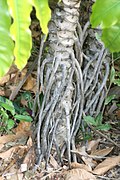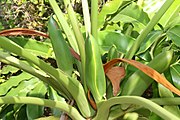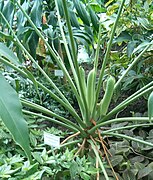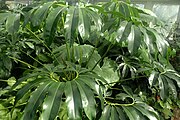
The Araceae are a family of monocotyledonous flowering plants in which flowers are borne on a type of inflorescence called a spadix. The spadix is usually accompanied by, and sometimes partially enclosed in, a spathe. Also known as the arum family, members are often colloquially known as aroids. This family of 114 genera and about 3,750 known species is most diverse in the New World tropics, although also distributed in the Old World tropics and northern temperate regions.

Philodendron is a large genus of flowering plants in the family Araceae. As of June 2013, the Plants of the World Online accepted 621 species; other sources accept different numbers. Regardless of number of species, the genus is the second-largest member of the family Araceae, after genus Anthurium. Taxonomically, the genus Philodendron is still poorly known, with many undescribed species. Many are grown as ornamental and indoor plants. The name derives from the Greek words philo- 'love, affection' and dendron 'tree'. The generic name, Philodendron, is often used as the English name.

Richard Spruce was an English botanist specializing in bryology. One of the great Victorian botanical explorers, Spruce spent 15 years exploring the Amazon from the Andes to its mouth, and was one of the very first Europeans to observe many of the places where he collected specimens. Spruce discovered and named a number of new plant species, and corresponded with some of the leading botanists of the nineteenth century.

Alocasia is a genus of rhizomatous or tuberous, broad-leaved, perennial, flowering plants from the family Araceae. There are about 90 accepted species native to tropical and subtropical Asia and eastern Australia. Around the world, many growers widely cultivate a range of hybrids and cultivars as ornamentals.

Anthurium is a genus of about 1,000 species of flowering plants, the largest genus of the arum family, Araceae. General common names include anthurium, tailflower, flamingo flower, pigtail plant, and laceleaf.

Lysichiton is a genus in the family Araceae. These plants are known commonly as skunk cabbage or less often as swamp lantern. The spelling Lysichitum is also found. The genus has two species, one found in north-east Asia, the other in north-west America.

Monstera is a genus of 59 species of flowering plants in the arum family, Araceae, native to tropical regions of central and south America.
Philodendron domesticum, also called the spadeleaf philodendron, the elephant ear philodendron, or burgundy philodendron, is a plant in the genus Philodendron. Its arrow-shaped glossy leaves grow to be 22 inches (56 cm) long and 9 inches (23 cm) wide when mature. Philodendron domesticum is also commonly grown as a houseplant in temperate climates.
Baursia is a section within the genus Philodendron that consists of 33 different species of plants. Philodendron species that are members of this section are typically described as having very prominent lateral veins. They also have elongated oblong leaves with a few species that are exceptions to this rule. Members of this section are usually found within southeastern South America and the upper amazon basin. The type species for this section is Philodendron crassinervium. Additionally, philodendron within this section have plurilocular ovaries.

Aroideae is a subfamily of flowering plants in the family Araceae. It is the largest subfamily in Araceae and consists of about 72 different genera, and 2,300 species. Many Aroideae have spiny pollen grains without a sporopollenin outer exine layer and lacking an aperture.

Thaumatophyllum bipinnatifidum is a plant in the genus Thaumatophyllum, in the family Araceae. Previously it was classified in the genus Philodendron within subgenus Meconostigma. The commonly used names Philodendron bipinnatifidum and Philodendron selloanum are synonyms. This plant is native to South America, namely to Brazil, Bolivia, Argentina, and Paraguay, but is also cultivated as a landscape plant in tropical, subtropical and warm temperate climates.

Montrichardia arborescens, the yautia madera, or moco-moco, is a tropical plant grows along river banks, swamps, or creeks to a maximum height of 9'. They consist of arrow shaped leaves that are food sources for animal species. The plant produces inflorescences which then leave a fruit of Montrichardia arborescens which is edible and can be cooked. Its fruiting spadices produces large infructescences, which contain about 80 edible yellow fruits.
Philonotion is a genus of plants in the family Araceae. It has three known species, native to tropical South America. Some authorities regard it as part of the related genus Schismatoglottis.
- Philonotion americanum(A.M.E.Jonker & Jonker) S.Y.Wong & P.C.Boyce - Brazil, Colombia, Venezuela, the Guianas
- Philonotion bolivaranum(G.S.Bunting & Steyerm.) S.Y.Wong & P.C.Boyce - Venezuela
- Philonotion spruceanumSchott - Venezuela, Colombia, Peru, Bolivia, northwestern Brazil

Thaumatophyllum is a genus of flowering plants in the arum family, Araceae. Its species are native to northern (tropical) South America.

Thaumatophyllum xanadu is a perennial plant belonging to the arum family Araceae and the genus Thaumatophyllum, formerly classified under the Meconostigma subgenus of Philodendron. This plant is native to Brazil, but is widely cultivated as a landscape plant in tropical, subtropical and warm temperate climates.
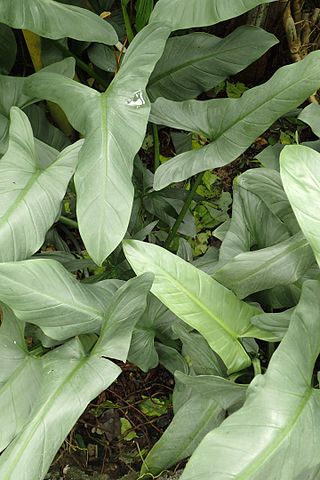
Philodendron hastatum is a species of plant in the genus Philodendron. The species has previously been known by synonyms such as Philodendron domesticum or other names, a confusion made worse by the large degree of morphological variation in this and similar Philodendrons. Commonly known as the silver sword philodendron, the plant is known for its silvery coloration, especially in juvenile leaves.
Gosong is a genus of flowering plants in the family Araceae. It has only one currently accepted species, Gosong brevipedunculata, native to Borneo. G. brevipedunculata is a rheophyte living alongside fast‑moving streams.
Thaumatophyllum adamantinum is a plant in the genus Thaumatophyllum, in the family Araceae. It is native to South America, namely to Southeast Brazil, but is also cultivated as a houseplant in cooler climates.

Philodendron spiritus-sancti is a species of plant in the genus Philodendron native to the Brazilian state of Espirito Santo, which is the origin of its scientific name. A member of the section Macrobelium, it has cordate foliage that can grow up to 57–63 centimetres (22–25 in) long. The width of the leaf blades is variable, and appears in three different forms known in cultivation.

Philodendron pedatum is a species of plant in the genus Philodendron native to South America from Colombia to southeast Brazil. It grows in wet tropical forests and like many in the genus, has a climbing growth habit.


